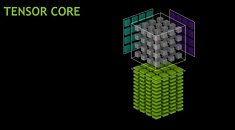- Joined
- Aug 19, 2017
- Messages
- 3,233 (1.12/day)
AMD's RDNA3 graphics IP is just around the corner, and we are hearing more information about the upcoming architecture. Historically, as GPUs advance, it is not unusual for companies to add dedicated hardware blocks to accelerate a specific task. Today, AMD engineers have updated the backend of the LLVM compiler to include a new instruction called Wave Matrix Multiply-Accumulate (WMMA). This instruction will be present on GFX11, which is the RDNA3 GPU architecture. With WMMA, AMD will offer support for processing 16x16x16 size tensors in FP16 and BF16 precision formats. With these instructions, AMD is adding new arrangements to support the processing of matrix multiply-accumulate operations. This is closely mimicking the work NVIDIA is doing with Tensor Cores.
AMD ROCm 5.2 API update lists the use case for this type of instruction, which you can see below:

View at TechPowerUp Main Site | Source
AMD ROCm 5.2 API update lists the use case for this type of instruction, which you can see below:
rocWMMA provides a C++ API to facilitate breaking down matrix multiply accumulate problems into fragments and using them in block-wise operations that are distributed in parallel across GPU wavefronts. The API is a header library of GPU device code, meaning matrix core acceleration may be compiled directly into your kernel device code. This can benefit from compiler optimization in the generation of kernel assembly and does not incur additional overhead costs of linking to external runtime libraries or having to launch separate kernels.
rocWMMA is released as a header library and includes test and sample projects to validate and illustrate example usages of the C++ API. GEMM matrix multiplication is used as primary validation given the heavy precedent for the library. However, the usage portfolio is growing significantly and demonstrates different ways rocWMMA may be consumed.

View at TechPowerUp Main Site | Source







